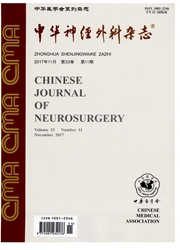

 中文摘要:
中文摘要:
目的探讨室管膜瘤的临床特征、治疗方法及预后。方法回顾性分析2002年1月至2010年12月在上海华山医院手术治疗的93例室管膜瘤患者临床资料,通过随访,分析无进展生存及总生存期的影响因素。结果本次研究组共随访到93例患者,平均年龄34.4岁(11个月-66岁),均接受肿瘤切除手术。19例位于幕上,35例幕下,39例脊髓。低级别病理59例,高级别病理34例。61例全切,45例接受术后放化疗。无进展生存期和肿瘤位置、手术切除程度及病理级别相关P〈0.05;总生存期和肿瘤位置相关P〈0.05。结论本项研究证实室管膜瘤的总生存期和肿瘤位置密切相关。此外,手术切除程度、病理级别、辅助治疗与无进展生存期相关,最后手术切除程度是室管膜瘤无进展生存期的独立预后因素。
 英文摘要:
英文摘要:
Objective To explore the clinical features treatment and survival of ependymomas. Method The clinical features, treatments and prognosis of 93 eases of ependymomas treated with microneurosurgery at the Huashan hospital from 2002 to 2010 were analyzed retrospectively. Results This series included 93 patients with median age 34. 4 years (11 months -66 years). 19 had tumors in supratentorial, 35 in infratentorial, and 39 in the spine. The majority were low grade lesions (59) vs high grade (anaplastic; 34). 61 patients had a gross total resection, and 45 received adjuvant therapy. The PFS was associated with tumor location, extent of surgery and pathology grade. OS was associated with tumor location. Conclusions The OS of ependymomas was associated with tumor location. Gross total removal, pathology grade and adjuvant therapy were associated with longer PFS. At last, Gross total removal was the independent prognostic indicators of PFS.
 同期刊论文项目
同期刊论文项目
 同项目期刊论文
同项目期刊论文
 期刊信息
期刊信息
